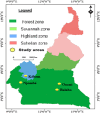Characterization of human exposure to Anopheles and Aedes bites using antibody-based biomarkers in rural zone of Cameroon
- PMID: 39637118
- PMCID: PMC11620597
- DOI: 10.1371/journal.pone.0314709
Characterization of human exposure to Anopheles and Aedes bites using antibody-based biomarkers in rural zone of Cameroon
Abstract
Malaria and Aedes-borne diseases remain major causes of mortality, morbidity, and disability in most developing countries. Surveillance of transmission patterns associated with vector control remains strategic for combating these diseases. Due to the limitions of current surveillance tools used to assess human exposure to mosquito bites, human antibody (Ab) responses to salivary peptides from Anopheles (gSG6-P1) and Aedes (Nterm-34kDa) are increasingly being used to measure direct human-Anopheles or Aedes contact. This study reports on the assessment of Human IgG Ab responses to gSG6-P1 and Nterm-34-kDa salivary peptides as biomarkers to track exposure to Anopheles and Aedes bites, in rural localities of Cameroon. Blood samples were collected between October and November 2022 from 173 individuals residing in four villages: Njombe, Kekem, Belabo, and Ouami. Sociodemographic characteristics and information regarding Long Lasting Insecticide Net (LLIN) ownership, use, and net characteristics were recorded using a questionnaire. The measurement of human IgG levels to gSG6-P1 and Nterm-34kDa peptides was conducted in blood samples using ELISA. The levels of IgG responses to Anopheles gSG6-P1 and Aedes Nterm-34kDa salivary peptides varied significantly across villages (all p<0.05). IgG responses to Anopheles gSG6-P1 were higher in Njombe compared to Belabo and Ouami (all p<0.01), while IgG responses to Aedes Nterm-34kDa were higher in Kekem compared to the other villages (all p<0.0001). Aweak correlation was observed between IgG responses to Anopheles and Aedes salivary peptides (Spearman r = 0.2689, p = 0.0003). However, the median level of IgG to Anopheles gSG6-P1 was higher than IgG to Aedes Nterm-34kDa in Njombé, Belabo, and Ouami. Individuals not using their LLIN, those using damaged bed nets, and those who reported vegetation around their houses developed higher IgG responses to gSG6-P1 and Nterm-34 kDa compared to those who did not (all p<0.05). The immune-epidemiological biomarkers have shown promising potential as indicators for monitoring human exposure to various mosquito bites and their heterogeneity in the same site. However, additional research is needed to validate the efficacy of this technique for surveillance purposes and to assess the effectiveness of vector control interventions.
Copyright: © 2024 Ngangue-Siewe et al. This is an open access article distributed under the terms of the Creative Commons Attribution License, which permits unrestricted use, distribution, and reproduction in any medium, provided the original author and source are credited.
Conflict of interest statement
The authors have declared that no competing interests exist.
Figures



Similar articles
-
Human IgG responses to Aedes mosquito salivary peptide Nterm-34kDa and its comparison to Anopheles salivary antigen (gSG6-P1) IgG responses measured among individuals living in Lower Moshi, Tanzania.PLoS One. 2022 Oct 27;17(10):e0276437. doi: 10.1371/journal.pone.0276437. eCollection 2022. PLoS One. 2022. PMID: 36301860 Free PMC article.
-
Spatial Assessment of Contact Between Humans and Anopheles and Aedes Mosquitoes in a Medium-Sized African Urban Setting, Using Salivary Antibody-Based Biomarkers.J Infect Dis. 2019 Aug 30;220(7):1199-1208. doi: 10.1093/infdis/jiz289. J Infect Dis. 2019. PMID: 31152664
-
Utility of plasma anti-gSG6-P1 IgG levels in determining changes in Anopheles gambiae bite rates in a rural area of Cameroon.Sci Rep. 2024 Jun 21;14(1):14294. doi: 10.1038/s41598-024-58337-8. Sci Rep. 2024. PMID: 38906949 Free PMC article.
-
Human antibodies against Anopheles salivary proteins: emerging biomarkers of mosquito and malaria exposure.Trends Parasitol. 2025 May;41(5):361-373. doi: 10.1016/j.pt.2025.03.009. Epub 2025 Apr 16. Trends Parasitol. 2025. PMID: 40246632 Review.
-
Anopheles salivary antigens as serological biomarkers of vector exposure and malaria transmission: A systematic review with multilevel modelling.Elife. 2021 Dec 23;10:e73080. doi: 10.7554/eLife.73080. Elife. 2021. PMID: 34939933 Free PMC article.
References
-
- World Health; Organization. (WHO). World malaria report 2023. Geneva: cdn.who.int.
MeSH terms
Substances
LinkOut - more resources
Full Text Sources
Medical

